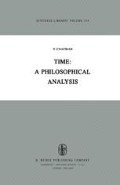Abstract
The CPT Theorem asserts a symmetry in nature, that under the combination of C, P and T reversal all physical reality must transform again into physical reality. The P stands for “parity”, i.e., right-left symmetry. For it to be conserved independently in all interactions would mean that the mirror-image of any physical process could occur. The “could” here is nomological, not logical since with the qualifications mentioned in the next section the mirror-image of any process is logically possible. The logical point is sometimes not made sufficiently clear that parity conservation would require that there be no difference between a physical process and its mirror-image other than this one (that the one is the mirror image of the other). C refers to “charge conjugation invariance”. For every particle in nature there exists an anti-particle, i.e., a particle having exactly the same properties except that its electric charge (if any) is opposite in sign. (The life-time of anti-particles in this region of the universe is very short since as soon as a particle encounters its anti- particle they are both annihilated and their mass converted completely into electromagnetic energy.) The symmetry of charge conjugation invariance would require that corresponding to every interaction involving particles there is an identical one involving anti-particles. It was shown in a famous experiment performed by the physicists Lee and Yang, the results of which were published in 1956, that parity is not conserved in the radio-active decay of cobalt-60.
Access this chapter
Tax calculation will be finalised at checkout
Purchases are for personal use only
Preview
Unable to display preview. Download preview PDF.
References
Norman Swartz, “Is There an Ozma-Problem for Time?” Analysis, Vol. 33, No. 3 (NS. 153) Jan., 1973, pp. 77–82.
Norman Swartz, “Is There an Ozma-Problem for Time?” Analysis, Vol. 33, No. 3 (NS. 153) Jan., 1973, p. 82.
This is elegantly spelled out by J. R. Lucas, A Treatise on Time and Space, London: Methuen, 1973, Section 8.
Author information
Authors and Affiliations
Rights and permissions
Copyright information
© 1982 D. Reidel Publishing Company, Dordrecht, Holland
About this chapter
Cite this chapter
Chapman, T. (1982). Temporal Asymmetry (continued). In: Time: A Philosophical Analysis. Synthese Library, vol 159. Springer, Dordrecht. https://doi.org/10.1007/978-94-009-7904-8_7
Download citation
DOI: https://doi.org/10.1007/978-94-009-7904-8_7
Publisher Name: Springer, Dordrecht
Print ISBN: 978-94-009-7906-2
Online ISBN: 978-94-009-7904-8
eBook Packages: Springer Book Archive

